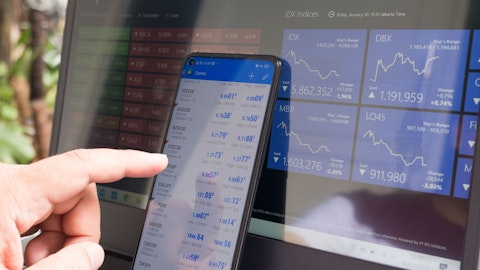MillerKnoll, Inc. (NASDAQ:MLKN) Q3 2024 Earnings Call Transcript March 27, 2024
MillerKnoll, Inc. beats earnings expectations. Reported EPS is $0.45, expectations were $0.44. MLKN isn’t one of the 30 most popular stocks among hedge funds at the end of the third quarter (see the details here).
Operator: Good evening, and welcome to the MillerKnoll’s Quarterly Earnings Conference Call. As a reminder, this call is being recorded. I would now like to introduce your host for today’s conference, Vice President of Investor Relations, Carola Mengolini.
Carola Mengolini: Good evening, and welcome to MillerKnoll’s Third Quarter Fiscal 2024 Conference Call. I am joined by Andi Owen, Chief Executive Officer; and Jeff Stutz, Chief Financial Officer. Also available during the Q&A session is John Michael, President of Americas Contract and Debbie Propst, President of Global Retail. Before I turn the call over to Andi, please remember our Safe Harbor regarding forward-looking information. During the call, management may discuss information that is forward-looking and involves known and unknown risks, uncertainties, and other factors, which may cause the actual results to be different than those expressed or implied. Please evaluate the forward-looking information in the context of these factors, which are detailed in today’s press release.
The forward-looking statements are as of today and we assume no obligation to update or supplement these statements. We may also refer to certain non-GAAP financial metrics, which are reconciled and described in our press release posted on our Investor Relations website at millerknoll.com. With that, I will turn the call over to Andi. Andi?
Andi Owen: Thanks, Carola, Good evening everyone. While this past quarter presented its challenges, we’re proud to highlight our resilience and strategic focus. Despite facing a lower volume of orders and sales, we maintained a steadfast commitment to enhancing our business operations. Our efforts yielded significant results as we successfully improved gross margins across all business segments, showcasing our ability to adapt and thrive in dynamic market conditions. MillerKnoll is an agile company. We have implemented several programs across our contract and retail business to boost demand, while also putting in place restructuring measures to better align our operating costs with the evolving economic landscape. With our MillerKnoll dealer network firmly established in the U.S., we’ve turned our focus now to showrooms, studios and tools that make it easier to create design solutions for customers.
Our showroom strategy is anchored in having fewer and more robust MillerKnoll design centers in targeted cities around the world. We’re bringing our brands together so that customers and design partners can experience the full breadth of our offering in one location. To this end, we will combine our showrooms in most markets and we will also invest more heavily in dealer showrooms and dealer programs, especially in markets without a corporate showroom presence. This work is already underway in several major U.S. markets, namely Chicago, Washington DC and the Greater Los Angeles area. This follows showroom colocation enhancements that we previously announced in New York City, Toronto and London. Simultaneously, in North America alone, more than 40 dealer’s showroom refreshes are in progress with many more planned.
At DWR, we recently opened a new concept studio in the San Francisco Design District. The space introduces our products in a new way, showcasing rotating galleries and interactive exhibits. We understand that enhancing our environment feels great results and we’ve been encouraged by the increased customer interest and foot traffic in this store. Across our retail experience, we know that most orders include a customer touch point in one of our stores. By enhancing these spaces in strategic locations, we believe it will continue to build market share, especially as macroeconomic conditions become more favorable. We are also making significant progress across our technology platform. This past January, we launched our program portal experience.
These are digital hubs which serve as a singular place for clients, dealers and our architecture and design partners to access projects and product information in one place, providing a forum for collaboration and streamlined processes. Similarly, we’ve launched augmented reality capabilities on retail and contract websites, a supplement to our highly functional 3D configurators. We’ve seen that customers who use these tools have a higher conversion rate and are faster to add products to the cart. These programs reflect the confidence we have in MillerKnoll’s long-term value and the opportunities ahead. However, we are re list and we understand that while encouraging, these initiatives and organizational enhancements are stepping stones to achieving our goals.
Existing demand pressures including the elevated cost of capital here in North America are affecting the housing and office space market and slowing the decisions related to capital expenditures. This is taking a toll on the short-term results of our business. To match the current demand environment this quarter, we implemented targeted workforce reductions and realigned our leadership team against our different business segments and geographic areas. These moves will have a meaningful impact on our SG&A cost structure. Jeff will share more details on this later. For our Americas business, while the third quarter is usually a softer period, the step up in activity that customarily comes to the end of the quarter did not materialize as expected.
Our team was fast to act however, focusing on price optimization and launching a series of initiatives to help our clients make decisions and therefore coax demand. We continue to see leading indicators trending positively. Client requests for mock ups are up over 20% year-over-year and contract activations and pricing requests are up over 30% in Q3. This quarter, we are very pleased to report growth across our international contract business as we continue to transition legacy Herman Miller dealers to full MillerKnoll dealers. The transition not only enhances the product portfolio of our existing dealerships, but also involves legacy dealers opening newly branded and furnished MillerKnoll showrooms, thereby enhancing our market presence. Furthermore, we also have aggressive plans underway to bring Knoll to new markets throughout Europe.
Our network around the globe is unmatched in reach and we are in a place to deliver designs for these regions as demand starts growing. Similarly, as macroeconomic pressures ease, we anticipate a release intent of retail demand and are preparing ourselves to meet this interest. Throughout our retail organization, we maintain a strong focus on inventory management and optimizing our product assortment. We’ve accelerated the introduction of more than 100 new styles to designs and reach, adding HAY, Muuto and Geiger products, introducing new DWR collections and expanding the assortment from our strategic third party vendors as well as building up the Knoll offering through additional finish and materials options. Furthermore, we’ve expanded our design services which has resulted in an increase in the penetration of orders from design services as well as fewer returns.
But right now, we are at 11-year low in the luxury housing market and our retail and specialty businesses track closely with that market. New home movers spend significantly more than the average. We’ll continue to watch Fed rates as they have the potential to move in our favor this year and when they do, we are prepared to capture the wins. Over the next few months, we will have exciting and significant opportunities to connect with our key clients around the globe and share the best of our collective with our core audiences at Salone and Milan and Design Days in Chicago. These are moments for us to visually demonstrate the forward thinking, innovative spirit that will carry us to the future while establishing meaningful connections. Ahead of these events, our research and insights team is conducting seminars in over 40 cities across 3 continents, sharing actionable insights with organizations on navigating changes in the way we work and adapting your spaces to our evolving world.
We’re highlighting several successful project profiles in the upcoming launch of season 4 of our About Place podcast. As companies navigate change and invest in their space, they continue to turn to us as a leader for our experienced database perspective on designing for tomorrow. Our industry has a once in a lifetime opportunity to redefine how we think about spaces for decades to come. We have a chance right now to push the spaces where we live and work to better support individual wellness, productivity and a sense of belonging. And when I look across our collective, there is no team more capable of rising to this occasion. We are focused and confident in the hard work we’re doing right now. As always, I thank you for your continued support in MillerKnoll, and I will pass it on to Jeff for a deeper dive into this quarter’s numbers.

Jeff?
Jeff Stutz : Thanks, Andi. Good evening, everyone. This afternoon we shared our third quarter results and I’m pleased to announce that we have achieved adjusted earnings per share of $0.45 in line with our guidance despite softer than expected revenue. The robust profitability we demonstrated this quarter showcases the resilience of our gross margin profile and underscores the efforts of our teams in protecting it. We delivered consolidated gross margin of 38.6% which improved more than 450 basis points over the prior year. This is our fifth consecutive quarter of year-over-year improvement in adjusted gross margin. Improved operational efficiency, moderating input and delivery costs, and incremental pricing benefits were the primary drivers all of which align with the themes we have consistently communicated as our focus over the past several quarters.
Furthermore, these actions were complemented by disciplined operating expense management and the ongoing benefit of our acquisition synergy program. As Andi mentioned, we took further steps this quarter aimed at improving the efficiency of our selling, general and administrative functions. This resulted in a targeted reduction of our management workforce. Additionally, we reviewed our real estate footprint and announced showroom consolidation plans in key markets which we believe will not only reduce our ongoing cost structure, but also create a more cohesive and compelling expression of our brand collective. Once fully implemented later this spring, these actions are expected to deliver annualized cost reductions of between $14 million and $16 million.
At the consolidated level, net sales in the third quarter of $872 million decreased 11.4% on a reported basis and 10.1% organically compared with the same quarter last year. New orders totaled $830 million reflecting an organic decrease 4.7% from the same quarter a year ago. While we saw declines in both the America’s contract and retail segments, demand levels in the International and Specialty segment were more encouraging, particularly in the contract component of our business. Although consolidated order levels for the full quarter did not meet our near-term expectations, the trend improved across all segments as we move through the period. And for the month of February, our consolidated orders were up 2.8% over last year. Within the Americas contract segment, net sales for the quarter were $441 million representing an organic decrease of 9.2% from the same quarter a year ago.
New orders in the period reflected a similar pattern coming in 9.4% lower than last year on an organic basis. Here again demand trends improved as we move through the period and into the early part of Q4. In fact over the last 2 weeks orders have trended up over 5% to last year. Despite lower sales versus last year, we again delivered much improved gross margins in the Americas segment this quarter. Net pricing benefit, moderating input costs, the realization of synergy benefits and tightly managed operating expenses contributed to achieving a gross margin of 33.1% and adjusted operating margin of 8.1%. Although, we’re not yet seeing their consistent impact on order rates, we remain highly optimistic that improvement is on the horizon given a range of forward-looking data points.
Indicators such as customer inquiries, project mock up requests and contract activations continue to grow year-over-year and the overall funnel of project opportunities remains encouraging. Within the funnel of projects, we are tracking the value of opportunities that we have won, but for which the actual order has not yet been received. We’re encouraged to share that this number is double the value it was this time last year. All of this adds to our confidence that we are at or near a demand inflection point in the business. The question remains however one of timing. By historical comparison, we continue to experience delays in the time it takes customers to make final order decisions and this has added to the complexity and challenge of forecasting the business.
Considering the current macroeconomic climate with elevated interest rates, lagging ABI readings and sentiment measures edging higher but still below pre-pandemic levels, none of this is surprising to us. Still the data we are tracking inside our business and what we hear from customers and our dealers gives us confidence that there is pent up demand awaiting further improvements in the macro backdrop. Turning to our International Contract and Specialty segment, net sales for the quarter totaled $217 million, which is down 10.6% organically year-over-year, while new orders came to $228 million reflecting a year-over-year organic increase of 7.9%. Demand patterns month-to-month continue to be inconsistent. However, orders grew in both December and February primarily driven by Mainland Europe, South Korea, India, China, Australia and in the Middle East.
One of our key strategic initiatives aimed at enhancing the scope and reach of our international network is completing the transition from Herman Miller to full line MillerKnoll dealers. This effort is steadily gaining momentum with currently over 40% of this network offering the MillerKnoll product portfolio. We have a consistent schedule of additional transitions planned in the upcoming quarter. We were also pleased with the margin profile of this segment. The adjusted operating margin was 10.4% in the third quarter, albeit down 110 basis points year-over-year due to lower sales volume. Despite this, we continue to expand gross margins. In this past quarter, we achieved a record level of 44.5% favorable product mix, improved freight and distribution management and proactive restructuring initiatives taken earlier in the year all contribute to this improved profit picture.
As it relates to our Global Retail segment, in the third quarter net sales totaled $214 million reflecting an organic decrease of 11.3%, while new orders totaled $183 million marking a 7.1% organic decline primarily due to subdued housing related demand. Regarding adjusted operating margin for the retail segment this quarter, we achieved 5.6%, 10 basis points higher than last year despite the decrease in net sales. The main drivers of the margin expansion were improved operational and delivery efficiency and favorable product mix. Despite the challenging retail environment, our retail team remains dedicated to improving in-store experiences, broadening our product offer, enhancing digital capabilities and elevating brand awareness. And we’re confident that this strategic approach will nurture brand loyalty, promote deeper engagement and position our business to take advantage of pent up demand as market conditions improve.
And we’re beginning to see signs of improvement in the economic data. As Andi mentioned, home sales in the U.S. are at 11-year lows demographic trends point to robust future construction growth. This is evidenced by last month’s homebuilder’s sentiment readings which posted its third consecutive monthly gain in February reaching its highest level since August of 2023. Moreover, renovation activity should also benefit from an aging housing stock and eventual turnover. As we mentioned to you last quarter, we believe that the demand fundamentals for this segment are pointing stronger and expect the retail segment to be a major contributor to both top and bottom line growth in our business for years to come. Regarding cash flow in the balance sheet this quarter, we saw cash generation of $61 million in cash from operations.
This enabled us to repurchase approximately 1.5 million shares for a total cash outlay of approximately $40 million. At quarter end, our net debt to EBITDA ratio was approximately 2.65x. Now let’s turn our near-term view to guidance and outlook. Given the macroeconomic conditions currently impacting our demand picture, we expect net sales the fourth quarter of fiscal 2024 to range between $880 million and $920 million. Adjusted diluted earnings per share for the period are expected to be $0.49 and $0.57. The midpoint of this earnings range implies year-over-year growth of approximately 29%, which is notable given the decline in year-over-year revenue. And based on this forecast, we expect full year adjusted diluted earnings per share of between $1.90 and $1.98.
While economic uncertainty certainly persists in parts of our business, we’re growing in our confidence that a favorable shift in demand patterns is on the horizon. And we believe this will translate into broad based sales and earnings growth as we move through the upcoming fiscal year. So, with that overview of the numbers, I’ll now turn the call over to the operator to take your questions.
See also 25 Rainiest States in the US and 15 US States that have the Death Penalty.
Q&A Session
Follow Millerknoll Inc. (NASDAQ:MLKN)
Follow Millerknoll Inc. (NASDAQ:MLKN)
Receive real-time insider trading and news alerts
Operator: [Operator Instructions] Our first question comes from the line of Greg Burns with Sidoti.
Greg Burns: Could you just talk about your win rates in the Americas and maybe why you think maybe it’s taking longer for some of this to move through your funnel? And do you feel like there’s been any changes in share in the market? And do you feel like you maybe need to get more aggressive with maybe some of your incentives to start converting maybe some of what you’re seeing in your pipeline? Thank you.
Andi Owen: Hey, Greg, it’s Andi. That’s a lot of questions, so I’ll start with a couple of points. First off, I think demand patterns in the early part of your recovery are always choppy, and they often really vary significantly based on customer size and industry sector. So I think that’s really kind of where we find ourselves currently, and I don’t think we’re either surprised or disheartened to see some relative differences across the competitive landscape and I think in fact every cycle in the last 25 years has played out this way. I think from a quarter-to-quarter fluctuation demand over the long term, we believe in the right position to protect our market share. From a timing perspective, I think it is still taking customers longer to make decisions on what’s in the funnel and what’s been won.
I think our win rate is actually 3% higher than last year, which is really encouraging. We are not seeing pricing activity that is frightening to us or it feels like we need to discount more. It feels very stable out there. We’re addressing pricing on a job by job basis, but we’re not feeling like it is incredibly competitive. John, I’d let you add a little bit more to that if you want.
John Michael: Yes, I would add Andi, if we look at what’s in the funnel in addition to significant increase in new opportunities added to the funnel, as you mentioned the win rate is up slightly and Jeff mentioned in his opening comments that as we track an opportunity through the sales process, the second to last step is it’s either marked closed or won and then the final step is it’s booked. And the amount of projects and opportunities in that final step closed won for us has increased significantly versus prior year. So it is really just a matter of timing in terms of that converting into an order. We’re still seeing construction delays and supply chain things in other industries that are impacting project timing. But again looking at all the leading indicators, they are all pointing in the right direction right now.
Greg Burns: And then, when you look at the balance sheet, obviously generating cash looks like you bought back some stock this quarter. Are you comfortable with the leverage here? Like why not, what’s your decision factor between buying back shares versus maybe paying down the debt?
Jeff Stutz: We have, this is, we’ve been buying some shares all fiscal year at different levels and we’ve just been opportunistic. We think the shares are undervalued. We think it’s good deal and a good investment. Now having said that we have been balanced. If you look at the course of the 1st 9 months of the fiscal year, we’ve taken a balanced approach in both bought shares and paid down some debt. This quarter just due to some timing of accessing some of our international cash, we did see our debt level tick up a little bit at the end of the quarter. But the intent has been in our plan going forward will continue be balanced on that front. No, we’re not concerned with the leverage ratio. Again, as we look ahead and we look at the internal measures that we’ve noted on the call, what we see our clouds clearing from a macroeconomic perspective and the trends we’ve even seen within each of the 3 business segments from an order entry standpoint, we’re confident we’re going to see demand improvements on the horizon.
Our margins are strong well above last year’s levels and so we’re quite comfortable with the level that we’re at.
Operator: Our next question comes from the line of Budd Bugatch with Water Tower Research.
Budd Bugatch: Congratulations on the profitability in the quarter. I know that’s a difficult thing and you’re managing that well. But I am concerned about what I see in the implied backlogs, particularly in the Americas contract, which looks to me to be somewhere, I think, probably in the $355 million to $360 million range, Jeff, if I did the math right?
Jeff Stutz: That’s right, Budd.
Budd Bugatch: And that’s the lowest backlog in America’s contract since before the acquisition, since the acquisition, time of the acquisition. And it makes it I think you told me it makes it very difficult to leverage your manufacturing at that same time, so irrespective of the pricing. What’s going on there? When will we see that backlog start to rise?
Jeff Stutz: Well, Budd, I won’t disagree with you that we everyone in this room is nodding. We have every interest to see order rates pick up and we’re spending our full efforts as an organization to support the sales organization to support the operations organization to drive order growth. And that’s what it’s going to take and I think we are as we said in the prepared comments we’re on the cusp of seeing order demand pick up. We saw some positive trends as we move through the quarter. I made the comment that Americas orders in the last couple of weeks have increased over last year same weeks prior year. So the trends are pointing in the right direction. I think the macro indicators as we’ve covered are pointing in the right direction.
We fully expect to see that backlog begin to grow, but you know we have been through 18 months or so of what I would call a contract economic recession and we’re finding our way to the bottom of it and we will find our way through the other side of it.




